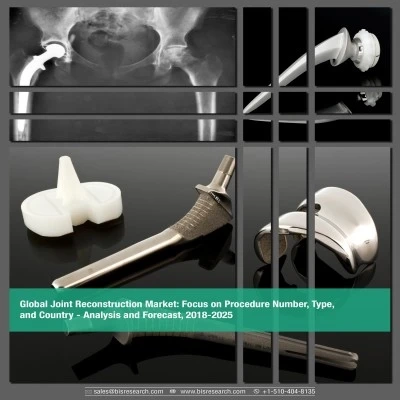Joint reconstruction procedures are performed to re-establish the architecture of a joint in order to reinstate the proper functioning of joint, thus reducing the pain in the process. The surgery involves the elimination of damaged part of the joint and replacing it with an artificially created joint that are designed to function as natural joints. The surgery is performed by a joint reconstruction specialist with sound knowledge in diagnosis, treatment, and prevention of injuries and diseases related to musculoskeletal system. The body parts which can undergo a joint reconstruction therapy are shoulder and elbow, wrist and hand, and hip and knee. Some of the widely known joint reconstruction surgeries include total knee replacement, total hip replacement, Anterior Cruciate Ligament (ACL) reconstruction, and chondroplasty, among others.
The growing prevalence of symptomatic osteoarthritis and post-traumatic arthritis due to the increasing geriatric population across the globe is significantly driving the demand for joint reconstruction procedures. In addition, conditions such as osteoporosis, facture, trauma, and sports injuries are also driving the growth of the joint reconstruction market. As of 2017, the global joint reconstruction market was estimated to be $16.82 billion and is expected to reach a value of $26.81 billion by the end of 2025, growing with a double digit CAGR during the forecast period. Furthermore, on a regional level, the U.S. occupied the largest share of the overall joint reconstruction market. The other major markets with significant volume include Germany, France, Italy, the U.K., Japan, and China.
Market Segmentation
The study majorly focusses on two broad categories of joint reconstruction therapy: product type and region. The product type segment is further sub-segmented as ‘hip’, ‘knee’, and ‘shoulder’. The hip replacement market (by product type) is further sub-segmented as ‘procedure type’, ‘fixation type’, and ‘bearing surfaces’. The knee replacement market is further sub-segmented as ‘procedure type’, ‘fixation type’, and ‘bearing type’. The shoulder replacement market is further sub-segmented as ‘procedure type’. The market (by region) is segmented as North America, Europe, Asia-Pacific and Latin America along with detailed country-wise analysis.
Based on the region the global joint reconstruction market is segmented into North America, Europe, Asia-Pacific, and Latin America. North America is the leading contributor to the global joint reconstruction market in terms of value and volume and is estimated to grow at the highest CAGR of 7.57% for hip joint replacement, 5.69% for shoulder replacement, and 8.02% in knee joint replacement.
Key Players
The key players who have been contributing significantly to the global joint reconstruction market include Altimed JSC, ARZZT, B. Braun Melsungen AG, Beijing Chunlizhengda Medical Instruments Co., Ltd., BioMedtrix, LLC, Biotech GmbH, Biotechni S.A.S, CeramTec Group, Corin Group PLC, Elite Surgical., Evolutis, Exactech, Inc., FX Solutions, Group FH Ortho, JOHNSON & JOHNSON, JRI Orthopaedics Limited, Lima Corporate, Marle Group, Mathys AG Bettlach, MatOrtho Limited, Menix Group, MicroPort Scientific Corporation, Peter Brehm GmbH, Smith & Nephew plc, StelKast, Stryker Corporation, Surgival (GRUPO COSÍAS), Wright Medical Group N.V., Zimmer Biomet Holdings, Inc., and among others.
Key Questions Answered in this Report:
• How did the joint reconstruction market evolve, and what is its scope in the future?
• What are the major market drivers, challenges, and opportunities in the global joint reconstruction market?
• What are the key strategies that are adopted by the key players to sustain in this market?
• What key factors are influencing the end users in the industry?
• What is the total number of procedures performed and the value of products used in the global joint reconstruction market?
• How different demographic groups will significantly impact the overall growth of the market?
• How will each segment of the global joint reconstruction market grow during the forecast period, and what will be the revenue generated by each of the segments by the end of 2025?
• How will the industry evolve during the forecast period 2018-2025?
• Who are the key players in the global joint reconstruction market, and what are their contributions?
Get Free Sample Report - https://bisresearch.com/requestsample?id=615&type=download
This research report aims at answering various aspects of the global joint reconstruction market with the help of the key factors driving the market, restraints and challenges that can possibly inhibit the overall market growth, and the current growth opportunities that are going to shape the future trajectory of the market expansion. The report includes an in-depth examination of the key players and recent developments taking place in this market. Moreover, the report includes chapters on market dynamics (market drivers, opportunities, and challenges) and industry analysis as well.
BIS Related Studies
Global Injectable Drug Delivery Market
Global Drug Infusion Systems Market
Global Blockchain in Healthcare Market
0


